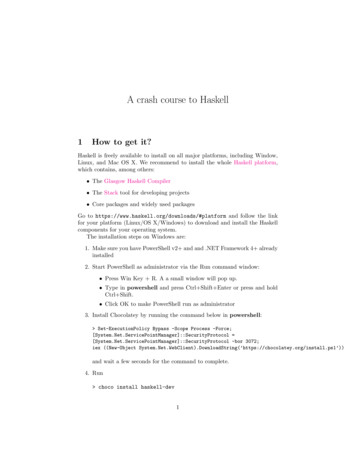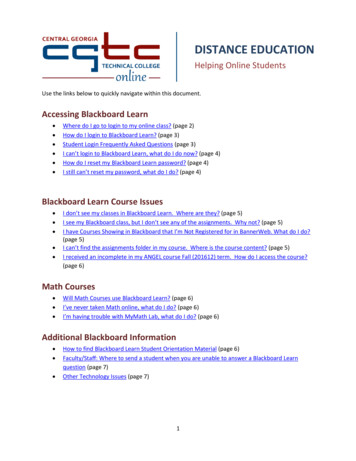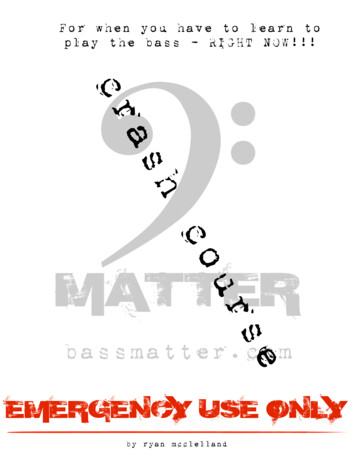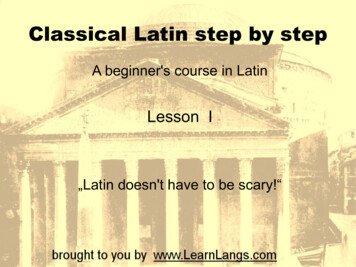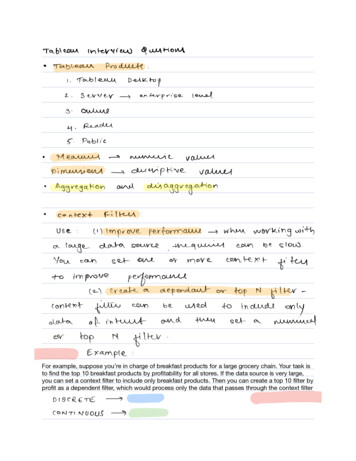
Transcription
Learn You a Haskell for Great Good!Miran Lipovača
2
Contents1Introduction1.1 About this tutorial . . . . . . . . . . . . . . . . . . . . . . . . . .1.2 So what’s Haskell? . . . . . . . . . . . . . . . . . . . . . . . . . .1.3 What you need to dive in . . . . . . . . . . . . . . . . . . . . . .2Starting Out2.1 Ready, set, go! . . . . . .2.2 Baby’s first functions . .2.3 An intro to lists . . . . .2.4 Texas ranges . . . . . . .2.5 I’m a list comprehension2.6 Tuples . . . . . . . . . . . .55679912131718213Types and Typeclasses3.1 Believe the type . . . . . . . . . . . . . . . . . . . . . . . . . . . .3.2 Type variables . . . . . . . . . . . . . . . . . . . . . . . . . . . . .3.3 Typeclasses 101 . . . . . . . . . . . . . . . . . . . . . . . . . . . .252527284Syntax in Functions4.1 Pattern matching4.2 Guards, guards! .4.3 Where!? . . . . . .4.4 Let it be . . . . .4.5 Case expressions56.333337394042Recursion5.1 Hello recursion! . . . . . . . . . .5.2 Maximum awesome . . . . . . .5.3 A few more recursive functions5.4 Quick, sort! . . . . . . . . . . . .5.5 Thinking recursively . . . . . . .454546474950Higher order functions6.1 Curried functions . . . . . . . . . .6.2 Some higher-orderism is in order6.3 Maps and filters . . . . . . . . . . .6.4 Lambdas . . . . . . . . . . . . . . .6.5 Only folds and horses . . . . . . .6.6 Function application with . . . .51. . 51. 53. 56. 59. . 61. 64.3
4CONTENTS6.7789Function composition . . . . . . . . . . . . . . . . . . . . . . . .Modules7.1 Loading modules . . . . .7.2 Data.List . . . . . . . . . .7.3 Data.Char . . . . . . . . .7.4 Data.Map . . . . . . . . . .7.5 Data.Set . . . . . . . . . . .7.6 Making our own modules65.69. 69. . 71. 79. 83.87. 88Making Our Own Types and Typeclasses8.1 Algebraic data types intro . . . . . . .8.2 Record syntax . . . . . . . . . . . . . .8.3 Type parameters . . . . . . . . . . . . .8.4 Derived instances . . . . . . . . . . . .8.5 Type synonyms . . . . . . . . . . . . .8.6 Recursive data structures . . . . . . .8.7 Typeclasses 102 . . . . . . . . . . . . .8.8 A yes-no typeclass . . . . . . . . . . .8.9 The Functor typeclass . . . . . . . . .8.10 Kinds and some type-foo . . . . . . .Input and Output9.1 Hello, world! . . . . . . . .9.2 Files and streams . . . . .9.3 Command line arguments9.4 Randomness . . . . . . . .9.5 Bytestrings . . . . . . . . .127. 128. 138. 150. 154. . 161.93939698. 10110510911311711912310 Functionally Solving Problems16510.1 Reverse Polish notation calculator . . . . . . . . . . . . . . . . . 16510.2 Heathrow to London . . . . . . . . . . . . . . . . . . . . . . . . . 169
Chapter 1Introduction1.1About this tutorialWelcome to Learn You a Haskell for Great Good! If you’re reading this,chances are you want to learn Haskell. Well, you’ve come to the right place,but let’s talk about this tutorial a bit first.I decided to write this because I wanted to solidify my own knowledge ofHaskell and because I thought I could help people new to Haskell learn it frommy perspective. There are quite a few tutorials on Haskell floating around onthe internet. When I was starting out in Haskell, I didn’t learn from just oneresource. The way I learned it was by reading several different tutorials andarticles because each explained something in a different way than the other did.By going through several resources, I was able put together the pieces and it alljust came falling into place. So this is an attempt at adding another useful resource for learning Haskell so you have a bigger chance of finding one you like.This tutorial is aimed at people who have experience in imperative programming languages (C, C , Java, Python . . . ) but haven’t programmed ina functional language before (Haskell, ML, OCaml . . . ). Although I bet thateven if you don’t have any significant programming experience, a smart chaplike you will be able to follow along and learn Haskell.The channel #haskell on the freenode network is a great place to askquestions if you’re feeling stuck. People there are extremely nice, patient andunderstanding to newbies.I failed to learn Haskell approximately 2 times before finally grasping itbecause it all just seemed too weird to me and I didn’t get it. But then onceit just “clicked” and after getting over that initial hurdle, it was pretty muchsmooth sailing. I guess what I’m trying to say is: Haskell is great and if you’reinterested in programming you should really learn it even if it seems weird atfirst. Learning Haskell is much like learning to program for the first time —it’s fun! It forces you to think differently, which brings us to the next section.5
61.2CHAPTER 1. INTRODUCTIONSo what’s Haskell?Haskell is a purely functional programming language. In imperative languages you get things done by giving the computer a sequence of tasks andthen it executes them. While executing them, it can change state. For instance,you set variable a to 5 and then do some stuff and then set it to something else.You have control flow structures for doing some action several times. In purelyfunctional programming you don’t tell the computer what to do as such butrather you tell it what stuff is. The factorial of a number is the product of allthe numbers from 1 to that number, the sum of a list of numbers is the firstnumber plus the sum of all the other numbers, and so on. You express that inthe form of functions. You also can’t set a variable to something and then setit to something else later. If you say that a is 5, you can’t say it’s somethingelse later because you just said it was 5. What are you, some kind of liar? Soin purely functional languages, a function has no side-effects. The only thinga function can do is calculate something and return it as a result. At first, thisseems kind of limiting but it actually has some very nice consequences: if afunction is called twice with the same parameters, it’s guaranteed to returnthe same result. That’s called referential transparency and not only does itallow the compiler to reason about the program’s behavior, but it also allowsyou to easily deduce (and even prove) that a function is correct and then buildmore complex functions by gluing simple functions together.Haskell is lazy. That means that unless specifically told otherwise, Haskellwon’t execute functions and calculate things until it’s really forced to showyou a result. That goes well with referential transparency and it allows youto think of programs as a series of transformations on data. It also allowscool things such as infinite data structures. Say you have an immutable listof numbers xs [1,2,3,4,5,6,7,8] and a function doubleMe which multipliesevery element by 2 and then returns a new list. If we wanted to multiply ourlist by 8 in an imperative language and did doubleMe(doubleMe(doubleMe(xs))),it would probably pass through the list once and make a copy and thenreturn it. Then it would pass through the list another two times and returnthe result. In a lazy language, calling doubleMe on a list without forcing itto show you the result ends up in the program sort of telling you “Yeahyeah, I’ll do it later!”. But once you want to see the result, the first doubleMetells the second one it wants the result, now! The second one says that tothe third one and the third one reluctantly gives back a doubled 1, whichis a 2. The second one receives that and gives back 4 to the first one. Thefirst one sees that and tells you the first element is 8. So it only does onepass through the list and only when you really need it. That way whenyou want something from a lazy language you can just take some initial dataand efficiently transform and mend it so it resembles what you want at the end.Haskell is statically typed. When you compile your program, the compilerknows which piece of code is a number, which is a string and so on. Thatmeans that a lot of possible errors are caught at compile time. If you try toadd together a number and a string, the compiler will whine at you. Haskelluses a very good type system that has type inference. That means that youdon’t have to explicitly label every piece of code with a type because the type
1.3. WHAT YOU NEED TO DIVE IN7system can intelligently figure out a lot about it. If you say a 5 4, you don’thave to tell Haskell that a is a number, it can figure that out by itself. Typeinference also allows your code to be more general. If a function you maketakes two parameters and adds them together and you don’t explicitly statetheir type, the function will work on any two parameters that act like numbers.Haskell is elegant and concise. Because it uses a lot of high level concepts,Haskell programs are usually shorter than their imperative equivalents. Andshorter programs are easier to maintain than longer ones and have less bugs.Haskell was made by some really smart guys (with PhDs). Work onHaskell began in 1987 when a committee of researchers got together to designa kick-ass language. In 2003 the Haskell Report was published, which definesa stable version of the language.1.3What you need to dive inA text editor and a Haskell compiler. You probably already have your favoritetext editor installed so we won’t waste time on that. The two main Haskell compilers as of right now are GHC (Glasgow Haskell Compiler) and Hugs. For thepurposes of this tutorial we’ll be using GHC. I won’t cover much installationdetails. On Windows it’s just a matter of downloading the installer and clicking“Next” a couple of times and then rebooting your computer. On Debian basedLinux distributions you can just do apt-get install ghc6 libghc6-mtl-dev andyou’re laughing. I don’t have a Mac but I’ve heard that if you have MacPorts,you can get GHC by doing sudo port install ghc. Also, I think you can doHaskell development with that wacky mouse with one button, although I’mnot sure.GHC can take a Haskell script (they usually have a .hs extension) andcompile it but it also has an interactive mode which allows you to interactivelyinteract with scripts. Interactively. You can call functions from scripts that youload and the results are displayed immediately. For learning it’s a lot easierand faster than compiling every time you make a change and then runningthe program from the prompt. The interactive mode is invoked by typingin ghci at your prompt. If you have defined some functions in a file called,say, myfunctions.hs, you load up those functions by typing in :l myfunctionsand then you can play with them, provided myfunctions.hs is in the samefolder from which ghci was invoked. If you change the .hs script, just run:l myfunctions again or do :r, which is equivalent because it reloads the currentscript. The usual workflow for me when playing around in stuff is definingsome functions in a .hs file, loading it up and messing around with them andthen changing the .hs file, loading it up again and so on. This is also whatwe’ll be doing here.
8CHAPTER 1. INTRODUCTION
Chapter 2Starting Out2.1Ready, set, go!Alright, let’s get started! If you’re the sort of horrible person who doesn’tread introductions to things and you skipped it, you might want to read thelast section in the introduction anyway because it explains what you need tofollow this tutorial and how we’re going to load functions. The first thingwe’re going to do is run ghc’s interactive mode and call some function to geta very basic feel for haskell. Open your terminal and type in ghci. You will begreeted with something like this.GHCi , version 6.8.2: http :// www . haskell . org / ghc /Loading package base . linking . done .Prelude :? for helpCongratulations, you’re in GHCI! The prompt here is Prelude but becauseit can get longer when you load stuff into the session, we’re going to use ghci .If you want to have the same prompt, just type in :set prompt "ghci ".Here’s some simple arithmetic.ghci 17ghci 4900ghci 420ghci 2.5ghci 2 1549 * 1001892 - 14725 / 2This is pretty self-explanatory. We can also use several operators on oneline and all the usual precedence rules are obeyed. We can use parentheses tomake the precedence explicit or to change it.ghci (50 * 100) - 49991ghci 50 * 100 - 49991ghci 50 * (100 - 4999)-2449509
10CHAPTER 2. STARTING OUTPretty cool, huh? Yeah, I know it’s not but bear with me. A little pitfallto watch out for here is negating numbers. If we want to have a negativenumber, it’s always best to surround it with parentheses. Doing 5 * -3 willmake GHCI yell at you but doing 5 * (-3) will work just fine.Boolean algebra is also pretty straightforward. As you probably know, &&means a boolean and, means a boolean or. not negates a True or a False.ghci Falseghci Trueghci Trueghci Trueghci FalseTrue && FalseTrue && TrueFalse Truenot Falsenot ( True && True )Testing for equality is done like so.ghci Trueghci Falseghci Falseghci Trueghci True5 51 05 / 55 / 4" hello " " hello "What about doing 5 "llama" or 5 True? Well, if we try the first snippet,we get a big scary error message!No instance for ( Num [ Char ])arising from a use of ‘ ’ at interactive :1:0 -9Possible fix : add an instance d
Welcome to Learn You a Haskell for Great Good! If you’re reading this, chances are you want to learn Haskell. Well, you’ve come to the right place, but let’s talk about this tutorial a bit first. I decided to write this because I wanted to solidify my own knowledge of Haskell and because I thought I could help people new to Haskell learn .File Size: 729KBPage Count: 176
